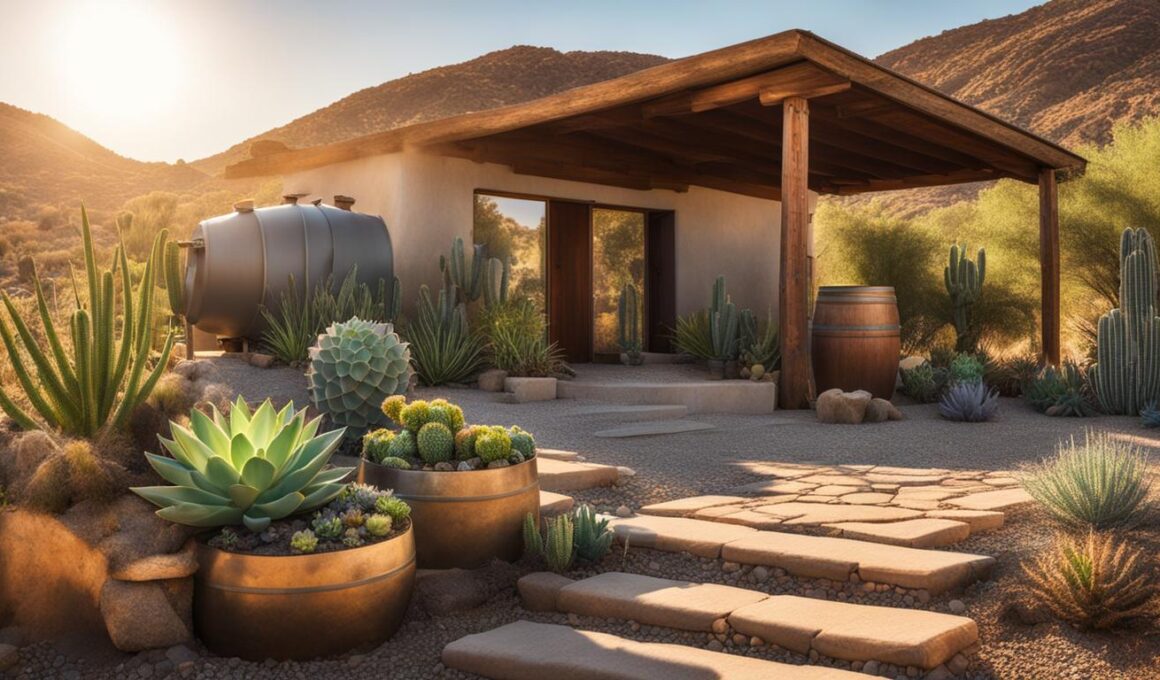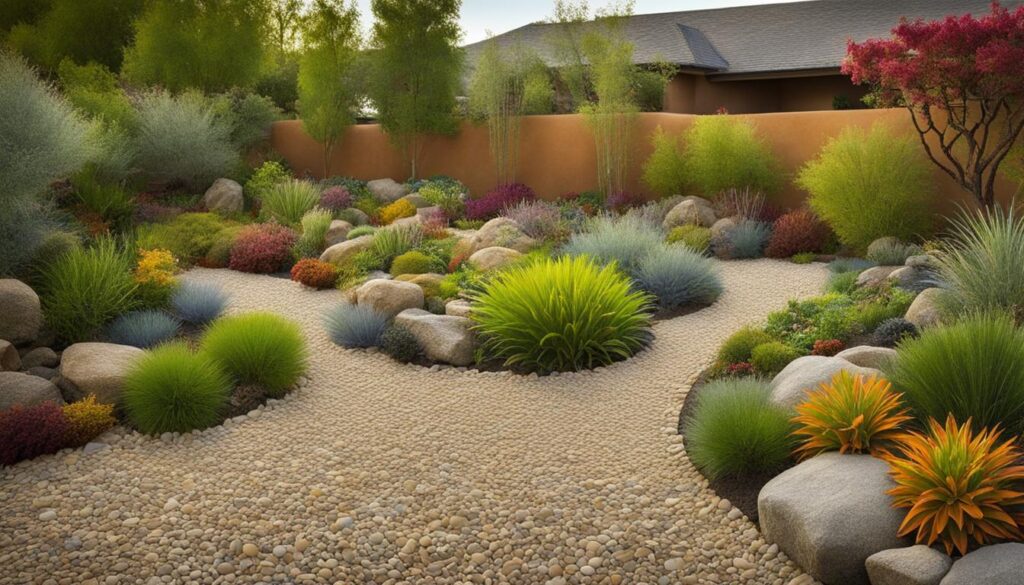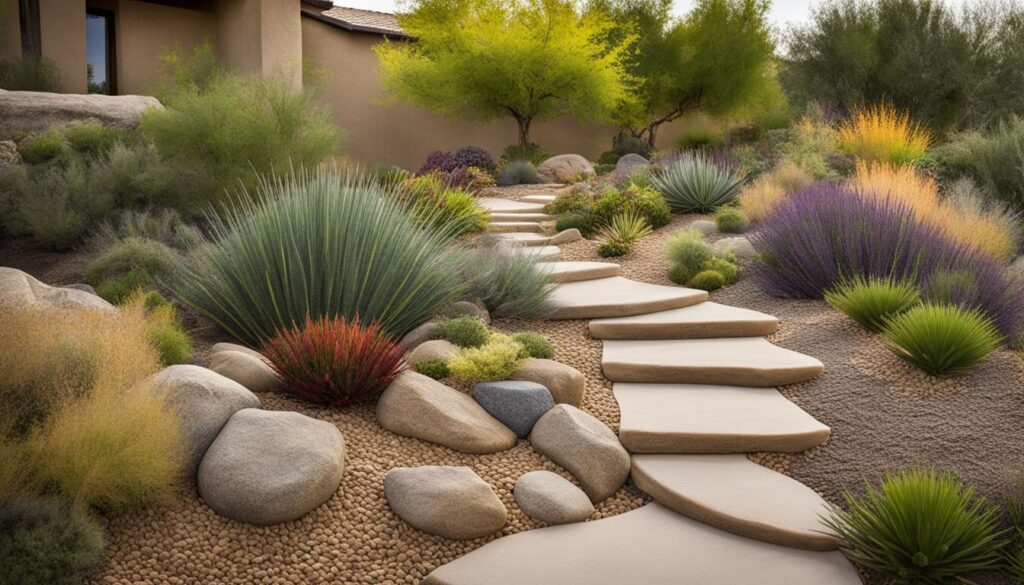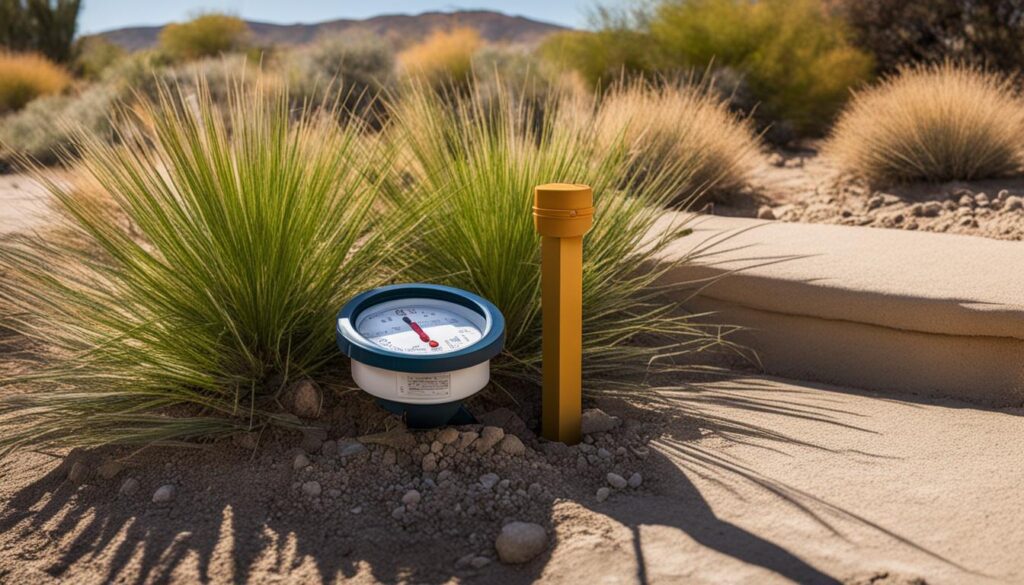Are you looking for ways to conserve water, save money, and create a stunning landscape? Look no further than xeriscaping! This drought-tolerant landscaping method focuses on using as little water as possible to maintain your yard. By incorporating xeriscaping principles such as efficient irrigation and the use of native plants, you can reduce water usage, lower your water bills, and contribute to water sustainability efforts. Whether you live in a drought-prone area or simply want a cost-effective and eco-friendly landscaping solution, xeriscaping is the answer.
Key Takeaways:
- Cost-effective: Implementing xeriscaping principles can save you money on water bills and landscaping maintenance.
- Water-saving: By using efficient irrigation techniques and drought-tolerant plants, xeriscaping significantly reduces water usage.
- Xeriscaping ideas: Incorporate native plants, mulching, and turf alternatives to create a beautiful and sustainable landscape.
- Environmentally friendly: Xeriscaping conserves water, supports natural ecosystems, and helps mitigate the impacts of climate change.
- DIY-friendly: Xeriscaping can be done on a budget by designing your own yard and using cost-effective materials.
What is Xeriscaping?
Xeriscaping, coined by Denver Water, is a landscaping method that aims to conserve water by using as little water as possible to maintain a yard. It is particularly popular in drought-prone areas and can be implemented in any yard. By incorporating practices such as efficient irrigation, mulching, and the use of drought-tolerant plants, homeowners can significantly reduce their water usage for landscaping purposes. Xeriscaping benefits both the environment and the homeowner by conserving water, reducing water bills, and creating a low-maintenance and sustainable landscape.
Implementing xeriscaping techniques involves understanding the importance of water conservation and making conscious choices in landscaping practices. By utilizing efficient irrigation systems, such as drip irrigation or rainwater harvesting, water usage is minimized while ensuring plants receive adequate moisture. Drought-tolerant plants, which are naturally suited to arid conditions, require less water and can flourish in xeriscaped yards. Mulching helps retain moisture in the soil, reducing evaporation, and suppressing weed growth.
Xeriscaping not only saves water but also reduces the need for chemical pesticides and fertilizers, promoting a healthier ecosystem. The use of native plants in xeriscaping helps support local biodiversity, as they are well-adapted to the climate and require less maintenance. In addition to its ecological benefits, xeriscaping can also contribute to cost savings on water bills and landscaping maintenance.
The benefits of xeriscaping include:
- Conserving water and promoting water sustainability
- Reducing water bills
- Creating a low-maintenance landscape
- Supporting local biodiversity and reducing the need for chemical pesticides and fertilizers
- Enhancing the aesthetic appeal of the yard with drought-tolerant plants
The 7 Principles of Xeriscaping
When it comes to creating a water-efficient and eco-friendly landscape, xeriscaping follows seven key principles. By implementing these principles, you can reduce water consumption, promote sustainability, and create a visually appealing outdoor space. Here are the seven principles of xeriscaping:
- Planning and Design: Proper planning and design are crucial for a successful xeriscape. Consider factors such as sun exposure, soil type, and water availability to determine the layout of your landscape.
- Soil Improvements: Prepare your soil by enhancing its quality and water-retention capabilities. Add organic matter, such as compost or mulch, to improve soil structure and promote plant growth.
- Efficient Irrigation: Use water-efficient irrigation systems, such as drip irrigation, to deliver water directly to the plant roots. This reduces water waste and ensures that plants receive the necessary moisture.
- Plant Zones: Group plants with similar water requirements together in designated zones. This allows for efficient watering and prevents overwatering or underwatering of certain plants.
- Mulches: Apply organic mulches, such as wood chips or straw, around plants to conserve moisture, suppress weed growth, and regulate soil temperature.
- Turf Alternatives: Minimize the use of traditional lawns and consider alternatives such as native grasses, ground covers, or hardscaping. These alternatives require less water and maintenance.
- Maintenance: Regular maintenance is essential to keep your xeriscape thriving. This includes proper watering, pruning, and weed control to ensure the longevity and beauty of your landscape.
Why Are These Principles Important?
The principles of xeriscaping are important because they promote water conservation, reduce reliance on irrigation, and create an eco-friendly landscape that is in harmony with its surrounding environment.
By embracing these principles, you can significantly reduce your water usage and contribute to the preservation of water resources. Additionally, xeriscaping minimizes the need for chemical fertilizers, pesticides, and excessive maintenance, making it a sustainable and cost-effective landscaping choice.
Implementing the seven principles of xeriscaping not only benefits the environment but also provides you with a beautiful and low-maintenance landscape. So why not start incorporating these principles into your outdoor space today?
Who Benefits From Xeriscaping?
Xeriscaping offers a wide range of benefits for homeowners, particularly those living in drought-prone areas. By implementing xeriscaping practices, you can conserve water, reduce your water bills, and contribute to water sustainability efforts. But the benefits of xeriscaping extend beyond water conservation.
One of the key advantages of xeriscaping is its cost-saving potential. With a well-designed xeriscape landscape, you can significantly lower your water usage, resulting in substantial savings on your water bills over time. Additionally, xeriscaping requires less maintenance compared to traditional landscaping, saving you time and effort.
Furthermore, xeriscaping promotes the creation of a low-maintenance and sustainable landscape. By incorporating drought-tolerant plants, efficient irrigation systems, and proper mulching techniques, you can create a vibrant and beautiful outdoor space that thrives under water-stressed conditions. Xeriscaping also helps in preserving natural ecosystems, protecting wildlife, and mitigating the impacts of climate change.
How Much Does Xeriscaping Cost?
Xeriscaping offers numerous benefits, including cost savings on water bills and creating a low-maintenance landscape. But how much does xeriscaping actually cost? The cost of xeriscaping can vary depending on several factors, such as the size of your yard, whether you hire a professional or do it yourself, and the materials you choose.
If you decide to hire a professional for your xeriscape landscaping, the average cost can range from $5 to $20 per square foot. For example, a 1,200-square-foot yard can cost around $17,000, while a smaller 500-square-foot yard may cost around $6,000. Keep in mind that these are just average estimates, and the actual cost will depend on your specific circumstances.
However, xeriscaping can also be done on a budget by taking a DIY approach. By designing the landscape yourself and doing the physical labor, you can significantly reduce costs. Additionally, opting for cost-effective elements such as seeds, plant cuttings, and homemade mulch can help keep expenses low. Xeriscaping on a budget is a great option for those who want to save money while still enjoying the benefits of a water-efficient and sustainable landscape.
Factors Affecting the Cost of Xeriscaping:
- Yard Size: The larger the yard, the more materials and labor will be required, which can increase the cost.
- Professional Assistance: Hiring a professional for design and installation can add to the overall cost of xeriscaping.
- Materials: The choice of materials, such as plants, irrigation systems, and mulch, can influence the cost of xeriscaping.
“Xeriscaping can be a cost-effective landscaping solution, especially when done on a budget by incorporating DIY methods and choosing cost-effective materials.” – Landscaping Expert
Regardless of the approach you take, xeriscaping offers a cost-effective landscaping option that not only saves you money but also helps conserve water and create a sustainable outdoor environment.
How to Xeriscape on a Budget
Implementing xeriscaping techniques in your yard doesn’t have to break the bank. With some careful planning and a little DIY effort, you can create a cost-effective and water-efficient landscape that will save you money in the long run. Here are some tips to help you xeriscape on a budget:
- Design your yard yourself: By taking charge of the design process, you can save on hiring a professional landscaper. Research xeriscaping ideas online and create a plan that suits your budget and aesthetic preferences.
- Do the physical labor: Enlist the help of friends or family members and make it a fun group project. By doing the physical labor yourself, you can save on the cost of hiring a landscaping crew.
- Opt for seeds and plant cuttings: Instead of buying fully-grown plants, consider starting from seeds or using cuttings from existing plants in your yard. This not only saves money but also allows you to propagate plants that are already adapted to your climate.
- Choose cost-effective elements: Instead of expensive concrete slabs and boulders, opt for more affordable options like shells and pebbles for pathways and borders. These materials can add visual interest to your landscape without breaking the bank.
Remember, xeriscaping is all about using resources wisely and making the most of what you have. With a little creativity and resourcefulness, you can achieve a beautiful, sustainable, and budget-friendly landscape.
In addition to these tips, homeowners living in drought-prone areas may be eligible for turf replacement rebates offered by the local government. These rebates can further reduce the cost of xeriscaping by providing financial incentives to replace water-intensive lawns with water-efficient landscape options. Be sure to check with your local water authority to see if you qualify for any rebates or incentives.
By following these budget-friendly xeriscaping tips and taking advantage of available resources, you can create a stunning and water-efficient landscape without breaking the bank. Xeriscaping is not only cost-effective but also a sustainable choice that helps conserve water and supports the environment.
How to Xeriscape Your Yard
Creating a water-efficient and sustainable landscape through xeriscaping is an excellent way to conserve water and beautify your yard. To get started on your xeriscaping journey, follow these step-by-step guidelines:
1. Make a Plan
Begin by drawing a map of your yard and identifying the sunny and shady areas. This will help you plan different zones for plants with varying water needs. Consider the size and shape of your yard, as well as any existing structures or features that you want to incorporate into your design.
2. Prepare Your Soil
Before planting, it’s essential to prepare your soil. Regrade the landscape if needed to ensure proper water drainage. Test the pH levels of your soil and make any necessary adjustments. Add compost or organic mulch to improve water retention and promote healthy plant growth.
3. Enhance Irrigation Systems
Efficient irrigation is key to water-efficient landscaping. Consider using drip irrigation systems to deliver water directly to the roots of plants, minimizing water waste. Additionally, capture rainwater in barrels or cisterns to supplement your irrigation needs and reduce reliance on freshwater sources.
4. Use Proper Mulches
Applying the right mulches is crucial to conserve water and reduce evaporation. Organic mulches, such as wood chips or straw, help retain moisture and insulate plant roots. Inorganic mulches, like rocks or gravel, can also be used effectively to conserve water and suppress weed growth.
5. Limit and Use Turf Appropriately
Turf areas require more water and maintenance compared to other landscaping elements. Consider limiting the amount of turf in your yard and reserving it for shaded areas where other plants may struggle to grow. This way, you can reduce water usage while still enjoying the benefits of having a lush green lawn.
6. Make Yard Maintenance a Priority
Regular maintenance is essential to keep your xeriscaped yard looking its best. Water your plants efficiently by following a proper watering schedule. Prune and trim plants as needed to promote healthy growth and remove any dead or diseased branches. Finally, continue mulching to retain moisture and suppress weed growth.
By following these step-by-step guidelines, you can successfully xeriscape your yard and create a water-efficient landscape that is both visually appealing and environmentally friendly.
How Can Xeriscaping Help Save Money on Water Bills?
Xeriscaping is a great way to reduce water usage and lower your xeriscape water bill reduction. By using drought-resistant plants and strategic landscaping techniques, you can significantly cut down on the amount of water needed to maintain your outdoor space. This can result in substantial savings on your monthly water bills.
How Can I Implement Xeriscaping Rebates and Water Conservation Techniques in a Cost-Effective Way?
Implementing xeriscaping rebates for water conservation can be a cost-effective way to minimize water usage. By utilizing drought-tolerant plants and efficient irrigation systems, you can significantly reduce water consumption in your landscape. Additionally, investing in rainwater harvesting and soil improvement techniques can further support water conservation efforts.
Conclusion
Xeriscaping offers numerous benefits to homeowners, including water conservation, cost savings, and the creation of a low-maintenance and sustainable landscape. By implementing the principles of xeriscaping and following the tips discussed in this article, you can transform your outdoor space while conserving water and saving money.
One of the key advantages of xeriscaping is its contribution to water conservation. By using efficient irrigation systems, limiting the use of turf, and incorporating drought-tolerant plants, you can significantly reduce your water usage for landscaping purposes. This not only helps combat water shortages but also promotes sustainability and protects natural ecosystems.
Another major benefit of xeriscaping is its cost-effectiveness. By designing your yard yourself, opting for cost-effective elements, and utilizing DIY methods, you can significantly reduce the overall cost of xeriscaping. Additionally, xeriscaping can lead to long-term cost savings through reduced water bills and lower maintenance requirements.
In conclusion, xeriscaping is a practical and eco-friendly solution to enhance your outdoor space while conserving water and saving money. By implementing the principles of xeriscaping and following the step-by-step process outlined in this article, you can create a beautiful and sustainable landscape that benefits both your wallet and the environment.













